[English] 日本語
 Yorodumi
Yorodumi- EMDB-8782: Phosphorylated, ATP-bound structure of zebrafish cystic fibrosis ... -
+ Open data
Open data
- Basic information
Basic information
| Entry | Database: EMDB / ID: EMD-8782 | |||||||||
|---|---|---|---|---|---|---|---|---|---|---|
| Title | Phosphorylated, ATP-bound structure of zebrafish cystic fibrosis transmembrane conductance regulator (CFTR) Phosphorylation Phosphorylation | |||||||||
 Map data Map data | Map with B-factor sharpened | |||||||||
 Sample Sample |
| |||||||||
 Keywords Keywords |  CFTR / CFTR /  anion channel / anion channel /  ABC transporter / ATP-bound. / ABC transporter / ATP-bound. /  HYDROLASE HYDROLASE | |||||||||
| Function / homology |  Function and homology information Function and homology informationABC-family proteins mediated transport / RHO GTPases regulate CFTR trafficking / Cargo recognition for clathrin-mediated endocytosis /  Clathrin-mediated endocytosis / RHOQ GTPase cycle / Kupffer's vesicle development / lymphoid lineage cell migration into thymus / Spemann organizer formation at the embryonic shield / Clathrin-mediated endocytosis / RHOQ GTPase cycle / Kupffer's vesicle development / lymphoid lineage cell migration into thymus / Spemann organizer formation at the embryonic shield /  regulation of neutrophil chemotaxis / Ub-specific processing proteases ...ABC-family proteins mediated transport / RHO GTPases regulate CFTR trafficking / Cargo recognition for clathrin-mediated endocytosis / regulation of neutrophil chemotaxis / Ub-specific processing proteases ...ABC-family proteins mediated transport / RHO GTPases regulate CFTR trafficking / Cargo recognition for clathrin-mediated endocytosis /  Clathrin-mediated endocytosis / RHOQ GTPase cycle / Kupffer's vesicle development / lymphoid lineage cell migration into thymus / Spemann organizer formation at the embryonic shield / Clathrin-mediated endocytosis / RHOQ GTPase cycle / Kupffer's vesicle development / lymphoid lineage cell migration into thymus / Spemann organizer formation at the embryonic shield /  regulation of neutrophil chemotaxis / Ub-specific processing proteases / Aggrephagy / regulation of neutrophil chemotaxis / Ub-specific processing proteases / Aggrephagy /  channel-conductance-controlling ATPase / intracellularly ATP-gated chloride channel activity / transepithelial water transport / germ cell migration / respiratory burst involved in defense response / multicellular organismal-level water homeostasis / bicarbonate transmembrane transporter activity / bicarbonate transport / channel-conductance-controlling ATPase / intracellularly ATP-gated chloride channel activity / transepithelial water transport / germ cell migration / respiratory burst involved in defense response / multicellular organismal-level water homeostasis / bicarbonate transmembrane transporter activity / bicarbonate transport /  pancreas development / embryonic hemopoiesis / pancreas development / embryonic hemopoiesis /  chloride channel activity / chloride channel activity /  chloride channel complex / T cell differentiation / ATPase-coupled transmembrane transporter activity / ABC-type transporter activity / cellular response to forskolin / chloride channel complex / T cell differentiation / ATPase-coupled transmembrane transporter activity / ABC-type transporter activity / cellular response to forskolin /  isomerase activity / chloride transmembrane transport / recycling endosome membrane / isomerase activity / chloride transmembrane transport / recycling endosome membrane /  heart development / early endosome membrane / defense response to bacterium / apical plasma membrane / heart development / early endosome membrane / defense response to bacterium / apical plasma membrane /  innate immune response / endoplasmic reticulum membrane / innate immune response / endoplasmic reticulum membrane /  ATP hydrolysis activity / ATP hydrolysis activity /  ATP binding / ATP binding /  membrane / membrane /  plasma membrane / plasma membrane /  cytosol cytosolSimilarity search - Function | |||||||||
| Biological species |   Danio rerio (zebrafish) Danio rerio (zebrafish) | |||||||||
| Method |  single particle reconstruction / single particle reconstruction /  cryo EM / Resolution: 3.37 Å cryo EM / Resolution: 3.37 Å | |||||||||
 Authors Authors | Zhang Z / Liu F / Chen J | |||||||||
 Citation Citation |  Journal: Cell / Year: 2017 Journal: Cell / Year: 2017Title: Conformational Changes of CFTR upon Phosphorylation and ATP Binding. Authors: Zhe Zhang / Fangyu Liu / Jue Chen /  Abstract: The cystic fibrosis transmembrane conductance regulator (CFTR) is an anion channel evolved from an ATP-binding cassette transporter. CFTR channel gating is strictly coupled to phosphorylation and ATP ...The cystic fibrosis transmembrane conductance regulator (CFTR) is an anion channel evolved from an ATP-binding cassette transporter. CFTR channel gating is strictly coupled to phosphorylation and ATP hydrolysis. Previously, we reported essentially identical structures of zebrafish and human CFTR in the dephosphorylated, ATP-free form. Here, we present the structure of zebrafish CFTR in the phosphorylated, ATP-bound conformation, determined by cryoelectron microscopy to 3.4 Å resolution. Comparison of the two conformations shows major structural rearrangements leading to channel opening. The phosphorylated regulatory domain is disengaged from its inhibitory position; the nucleotide-binding domains (NBDs) form a "head-to-tail" dimer upon binding ATP; and the cytoplasmic pathway, found closed off in other ATP-binding cassette transporters, is cracked open, consistent with CFTR's unique channel function. Unexpectedly, the extracellular mouth of the ion pore remains closed, indicating that local movements of the transmembrane helices can control ion access to the pore even in the NBD-dimerized conformation. | |||||||||
| History |
|
- Structure visualization
Structure visualization
| Movie |
 Movie viewer Movie viewer |
|---|---|
| Structure viewer | EM map:  SurfView SurfView Molmil Molmil Jmol/JSmol Jmol/JSmol |
| Supplemental images |
- Downloads & links
Downloads & links
-EMDB archive
| Map data |  emd_8782.map.gz emd_8782.map.gz | 200.1 MB |  EMDB map data format EMDB map data format | |
|---|---|---|---|---|
| Header (meta data) |  emd-8782-v30.xml emd-8782-v30.xml emd-8782.xml emd-8782.xml | 15.4 KB 15.4 KB | Display Display |  EMDB header EMDB header |
| Images |  emd_8782.png emd_8782.png | 59.4 KB | ||
| Filedesc metadata |  emd-8782.cif.gz emd-8782.cif.gz | 6.4 KB | ||
| Others |  emd_8782_additional.map.gz emd_8782_additional.map.gz | 23.8 MB | ||
| Archive directory |  http://ftp.pdbj.org/pub/emdb/structures/EMD-8782 http://ftp.pdbj.org/pub/emdb/structures/EMD-8782 ftp://ftp.pdbj.org/pub/emdb/structures/EMD-8782 ftp://ftp.pdbj.org/pub/emdb/structures/EMD-8782 | HTTPS FTP |
-Related structure data
| Related structure data |  5w81MC M: atomic model generated by this map C: citing same article ( |
|---|---|
| Similar structure data |
- Links
Links
| EMDB pages |  EMDB (EBI/PDBe) / EMDB (EBI/PDBe) /  EMDataResource EMDataResource |
|---|---|
| Related items in Molecule of the Month |
- Map
Map
| File |  Download / File: emd_8782.map.gz / Format: CCP4 / Size: 216 MB / Type: IMAGE STORED AS FLOATING POINT NUMBER (4 BYTES) Download / File: emd_8782.map.gz / Format: CCP4 / Size: 216 MB / Type: IMAGE STORED AS FLOATING POINT NUMBER (4 BYTES) | ||||||||||||||||||||||||||||||||||||||||||||||||||||||||||||
|---|---|---|---|---|---|---|---|---|---|---|---|---|---|---|---|---|---|---|---|---|---|---|---|---|---|---|---|---|---|---|---|---|---|---|---|---|---|---|---|---|---|---|---|---|---|---|---|---|---|---|---|---|---|---|---|---|---|---|---|---|---|
| Annotation | Map with B-factor sharpened | ||||||||||||||||||||||||||||||||||||||||||||||||||||||||||||
| Voxel size | X=Y=Z: 0.82 Å | ||||||||||||||||||||||||||||||||||||||||||||||||||||||||||||
| Density |
| ||||||||||||||||||||||||||||||||||||||||||||||||||||||||||||
| Symmetry | Space group: 1 | ||||||||||||||||||||||||||||||||||||||||||||||||||||||||||||
| Details | EMDB XML:
CCP4 map header:
| ||||||||||||||||||||||||||||||||||||||||||||||||||||||||||||
-Supplemental data
-Additional map: Original map from Frealign without B-factor sharpening
| File | emd_8782_additional.map | ||||||||||||
|---|---|---|---|---|---|---|---|---|---|---|---|---|---|
| Annotation | Original map from Frealign without B-factor sharpening | ||||||||||||
| Projections & Slices |
| ||||||||||||
| Density Histograms |
- Sample components
Sample components
-Entire : zebrafish cystic fibrosis transmembrane conductance regulator (CFTR)
| Entire | Name: zebrafish cystic fibrosis transmembrane conductance regulator (CFTR) |
|---|---|
| Components |
|
-Supramolecule #1: zebrafish cystic fibrosis transmembrane conductance regulator (CFTR)
| Supramolecule | Name: zebrafish cystic fibrosis transmembrane conductance regulator (CFTR) type: complex / ID: 1 / Parent: 0 / Macromolecule list: #1 |
|---|---|
| Source (natural) | Organism:   Danio rerio (zebrafish) Danio rerio (zebrafish) |
| Molecular weight | Theoretical: 168 kDa/nm |
-Macromolecule #1: Cystic fibrosis transmembrane conductance regulator
| Macromolecule | Name: Cystic fibrosis transmembrane conductance regulator / type: protein_or_peptide / ID: 1 / Number of copies: 1 / Enantiomer: LEVO / EC number:  ec: 3.6.3.49 ec: 3.6.3.49 |
|---|---|
| Source (natural) | Organism:   Danio rerio (zebrafish) Danio rerio (zebrafish) |
| Molecular weight | Theoretical: 169.620812 KDa |
| Recombinant expression | Organism:   Homo sapiens (human) Homo sapiens (human) |
| Sequence | String: MQRSPVEDAN CLSRYFFWWT NPIMRKGFKE KLRPSDVYQA PSQDAADILA ERLEKEWDRE VASGKKKPSL LRAMARCYIK PFLLFGFLL YIGEATKTVQ PQLLGRIIAS FDPAHEPERA NGYFLAFGLG LLFTARFLLL QPAMFGLHHL GMQIRIALFS I IYKKTLKL ...String: MQRSPVEDAN CLSRYFFWWT NPIMRKGFKE KLRPSDVYQA PSQDAADILA ERLEKEWDRE VASGKKKPSL LRAMARCYIK PFLLFGFLL YIGEATKTVQ PQLLGRIIAS FDPAHEPERA NGYFLAFGLG LLFTARFLLL QPAMFGLHHL GMQIRIALFS I IYKKTLKL SSRVLDKIST GQLVSLMSAN LGKFDQSLGM AHFIWISPLQ CILCTGLIWE LIDVNSFCAL AAISLLGVLQ AF LSHKMGP YKAQKVLLTN KRLALTSEIM ENLHSVKAYG WEEIMETLIK NIRQDEVKLT RKIGSLRYFY SSAYFFSAIF VIV AAVVPH ALSRGINLRR IFTTLSYCMV LRMTVTRQLP GSIQMWYDTM RLIWKIEEFL SKEEYKLMEY DLSITELELQ DVTA SWDEG PGELLERIKQ ENKANGHHNG DAGLFFTNLY VAPVLKDISL KLKKGEMLAV TGSMGSGKSS LLMTILGELV PSSGK IRHS GRISYSSQTA WIMPGTIRDN ILFGLTYDEY RYKSVVKACQ LEEDLAALPE KDKTPMAEGG LNLSGGQKAR VALARA VYR DADLYLLDAP FTHLDIATEK EIFDKCLCKL MASKTRILVT NKIEHLKRAD KILLLHNGES FFYGTFPELQ SERPDFS SL LLGLEAYDNI SAERRCSILT ETLHRVSVDE SAGMQPERSA FRQVPPTKPM YIDERKASVI VNPLGVARKA SFIQVPEE E VRRTLPDRKF SLVPENELVD ESFMGSDVYH NHGVHMAGQR RQSVLAFMTN AQGQGRREHL QSSFRRRLSV VPQSELASE LDIYTRRLSD STYDMTGILE EENIEACLTD EIDEIEETFE TTKWNTYVRY VSNNKSLLYV LIFILFIAAI EIAGSVAGIF LITDELWRE EHQRSEPNMT KHSNASSSGQ TYAITVTPTS SYYILYIYVA TSESLLAMGF FRGLPFVHTT ITISKKLHQK M LHAVLSAP MSVLNTMKTG RIMNRFTKDM ATIDDMLPLL MFDFVQLTVV VVGCILVVSI VRPYIFLAAT PLAIIFIVMR KY FLRTGQQ LKQLETEARS PIFSHLIMSL KGLWTIRAFE RQAYFEALFH KTLNTHTATW FLYLSTLRWF LFRADILFVF FFT LAAWIA VGTNQDKPGE IGIIICLAML ILGTFQWCVA TSIAVDGMMR SVDRVFKFID LPSETPKPDK GKDSDLIIEN VDAQ ADSSW PHRGQIEVRN LTVKYTEAGH AVLKNLSFSA EGRQRVGILG RTGSGKSSLF NALLKLVYTD GEISIDGVNW NKMPL QKWR KAFGVVPQKV FIFTGPLRMN LDPYGCHSDE ELWRVAEEVG LKTVIEQFPD KLDFQLEYGG YVLSNGHKQL ICLARS ILS GARILLLDQP SAHLDPVTIK VLKKTLRQSF STCTILLSEH KVEPLLECQS FLMMDKGQVK TYDSIQKLLN ETSHLKQ AI SPAERLKLFP RRNSSMRTPQ SKLSSVTQTL QEEAEDNIQD TRLSNSLEVL FQ UniProtKB:  Cystic fibrosis transmembrane conductance regulator Cystic fibrosis transmembrane conductance regulator |
-Macromolecule #2: ADENOSINE-5'-TRIPHOSPHATE
| Macromolecule | Name: ADENOSINE-5'-TRIPHOSPHATE / type: ligand / ID: 2 / Number of copies: 2 / Formula: ATP |
|---|---|
| Molecular weight | Theoretical: 507.181 Da |
| Chemical component information |  ChemComp-ATP: |
-Macromolecule #3: MAGNESIUM ION
| Macromolecule | Name: MAGNESIUM ION / type: ligand / ID: 3 / Number of copies: 2 / Formula: MG |
|---|---|
| Molecular weight | Theoretical: 24.305 Da |
-Experimental details
-Structure determination
| Method |  cryo EM cryo EM |
|---|---|
 Processing Processing |  single particle reconstruction single particle reconstruction |
| Aggregation state | particle |
- Sample preparation
Sample preparation
| Concentration | 5.5 mg/mL |
|---|---|
| Buffer | pH: 7.5 |
| Grid | Model: Quantifoil R1.2/1.3 / Material: GOLD / Mesh: 400 |
| Vitrification | Cryogen name: ETHANE |
- Electron microscopy
Electron microscopy
| Microscope | FEI TITAN KRIOS |
|---|---|
| Electron beam | Acceleration voltage: 300 kV / Electron source:  FIELD EMISSION GUN FIELD EMISSION GUN |
| Electron optics | Illumination mode: FLOOD BEAM / Imaging mode: BRIGHT FIELD Bright-field microscopy / Nominal defocus max: 2.5 µm / Nominal defocus min: 0.8 µm / Nominal magnification: 61199 Bright-field microscopy / Nominal defocus max: 2.5 µm / Nominal defocus min: 0.8 µm / Nominal magnification: 61199 |
| Sample stage | Cooling holder cryogen: NITROGEN |
| Image recording | Film or detector model: GATAN K2 SUMMIT (4k x 4k) / Detector mode: SUPER-RESOLUTION / Digitization - Dimensions - Width: 7420 pixel / Digitization - Dimensions - Height: 7676 pixel / Digitization - Frames/image: 1-50 / Number grids imaged: 2 / Number real images: 7434 / Average exposure time: 0.14 sec. / Average electron dose: 1.68 e/Å2 |
| Experimental equipment |  Model: Titan Krios / Image courtesy: FEI Company |
- Image processing
Image processing
| Particle selection | Number selected: 900000 |
|---|---|
| Startup model | Type of model: EMDB MAP EMDB ID: |
| Initial angle assignment | Type: ANGULAR RECONSTITUTION / Software - Name: RELION (ver. 2.0) |
| Final 3D classification | Number classes: 4 / Software - Name: RELION (ver. 2.0) |
| Final angle assignment | Type: ANGULAR RECONSTITUTION / Software - Name: FREALIGN (ver. 9.11) |
| Final reconstruction | Applied symmetry - Point group: C1 (asymmetric) / Resolution.type: BY AUTHOR / Resolution: 3.37 Å / Resolution method: FSC 0.143 CUT-OFF / Software - Name: FREALIGN (ver. 9.11) / Number images used: 777102 |
 Movie
Movie Controller
Controller





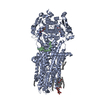
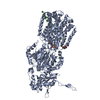

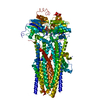
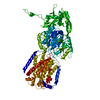


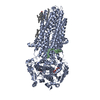


 Z
Z Y
Y X
X










